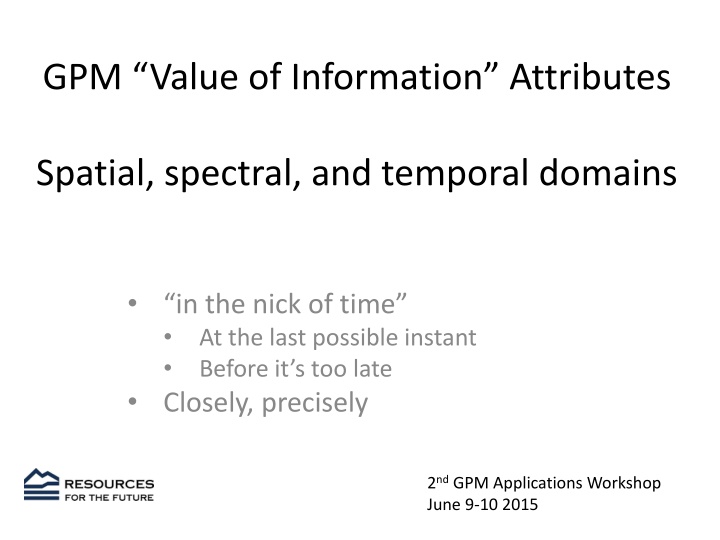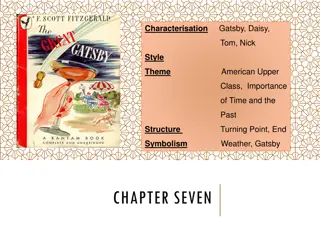
The Value of Information Attributes in Environmental Conservation
Explore the significance of spatial, spectral, and temporal information domains in conservation efforts, highlighting the benefits of early warning systems and the role of marine reserves in enhancing ecosystem resilience. Learn from empirical studies on the impact of extreme weather events on coastal ecosystems and the effectiveness of conservation strategies in mitigating damage.
Download Presentation

Please find below an Image/Link to download the presentation.
The content on the website is provided AS IS for your information and personal use only. It may not be sold, licensed, or shared on other websites without obtaining consent from the author. If you encounter any issues during the download, it is possible that the publisher has removed the file from their server.
You are allowed to download the files provided on this website for personal or commercial use, subject to the condition that they are used lawfully. All files are the property of their respective owners.
The content on the website is provided AS IS for your information and personal use only. It may not be sold, licensed, or shared on other websites without obtaining consent from the author.
E N D
Presentation Transcript
GPM Value of Information Attributes Spatial, spectral, and temporal domains in the nick of time At the last possible instant Before it s too late Closely, precisely 2nd GPM Applications Workshop June 9-10 2015
Warning expectation as an indicator of optimal alert 1 100 0.8 80 Benefit (Cost)[Mio ] Warning reliability 0.6 60 0.4 40 0.2 20 0 0 1 2 3 4 5 6 Lead time [hrs] warning expectation avoidable damage warning reliability mitigation cost Source: Scroter et al., 2008, in Rogers and Tsirkunov, 2010, Costs and benefits of early warning systems
http://www.gbrmpa.gov.au/managing-the-reef/threats-to-the-reef/extreme-http://www.gbrmpa.gov.au/managing-the-reef/threats-to-the-reef/extreme- weather/management-responses accessed May 10 2015 Extreme Weather Threatens Rich Ecosystems, 30 March 2012 at http://www.sciencedaily.com/releases/2012/03/120330110535.htm accessed May 10 2015
Figure 3.2 Distribution of Carbon Storage in Mangrove Ecosystems, by Latitude Figure 4.1 Opportunity Cost of Avoided Carbon Emissions ($ t C-1), by Country Blue Carbon: Global Options for Reducing Emissions from the Degradation and Development of Coastal Ecosystems, Juha Siikamaki, James Sanchirico, et al, 2012, at http://www.rff.org/RFF/Documents/RFF-Rpt-2012-BlueCarbon_final_web.pdf
Abstract Natural ecosystems have experienced widespread degradation due to human activities. Consequently, enhancing resilience has become a primary objective for conservation. Nature reserves are a favored management tool, but we need clearer empirical tests of whether they can impart resilience. Catastrophic flooding in early 2011 impacted coastal ecosystems across eastern Australia. We demonstrate that marine reserves enhanced the capacity of coral reefs to withstand flood impacts. Reserve reefs resisted the impact of perturbation, whilst fished reefs did not. Changes on fished reefs were correlated with the magnitude of flood impact, whereas variation on reserve reefs was related to ecological variables. Herbivory and coral recruitment are critical ecological processes that underpin reef resilience, and were greater in reserves and further enhanced on reserve reefs near mangroves. The capacity of reserves to mitigate external disturbances and promote ecological resilience will be critical to resisting an increased frequency of climate-related disturbance. Andrew D. Olds, Kylie A. Pitt et al., 2014, Marine reserves help coastal ecosystems cope with extreme weather, Global Change Biology 20(10): 3050-3058
Likelihood of taking action and/or costs in light of these types of estimates may depend on expected frequency and severity Source: see previous slide
https://www.fema.gov/media-library/assets/documents/24609?id=5120 accessed May 12 2015



















